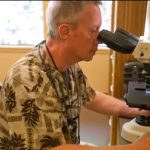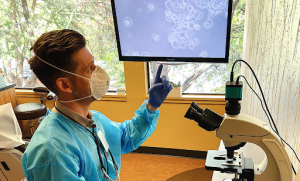
This is a quick, non-invasive procedure that we use on all of our patients to help evaluate their periodontal (gum) health. It allows us to identify profiles of dental plaque bacteria that we know correlate with periodontal infection. Without this tool, many cases of periodontal pathology would go undetected and un- or under-diagnosed. We consider it to be an essential screening tool for periodontal health as well as a valuable monitoring tool for the effectiveness of periodontal treatment.
How does it work?

The dentist or dental staff member takes a small sample of the soft dental plaque at the gumline of the teeth and places it on a microscope slide. The live plaque sample is viewed on a powerful “phase contrast” microscope and evaluated. Patients can also view this magnified sample live on a monitor in the treatment room. The results will be explained and recorded in your file for future comparison.
What does the sample look like under the microscope? Check below under “Videos”
History
Beginning in the late 1950s, Dr. Paul Keyes, a dentist then working at the National Institute of Health, developed this method of microscopically studying dental plaque to identify periodontal pathogenic organisms. Most dental students have at least been exposed to this idea, but very few dentists actually use phase contrast microscopy in their practice. The International Academy of Oral Medicine and Toxicology (IAOMT) made it a part of their recommended protocols for diagnosing and treating gum disease over 30 years ago, and that is when and how this method became incorporated as a part of our practice and many other “biological” or “holistic” dental practices.
This one simple but sophisticated method, unavailable in most other offices, truly helps us to tailor our treatment recommendations to your unique biology.
Links
Protocol for holistic periodontal therapy
Dr. Paul H. Keyes’ Non-Surgical Solution to Oral Health
Oral infection diagnostic resources
Videos:


